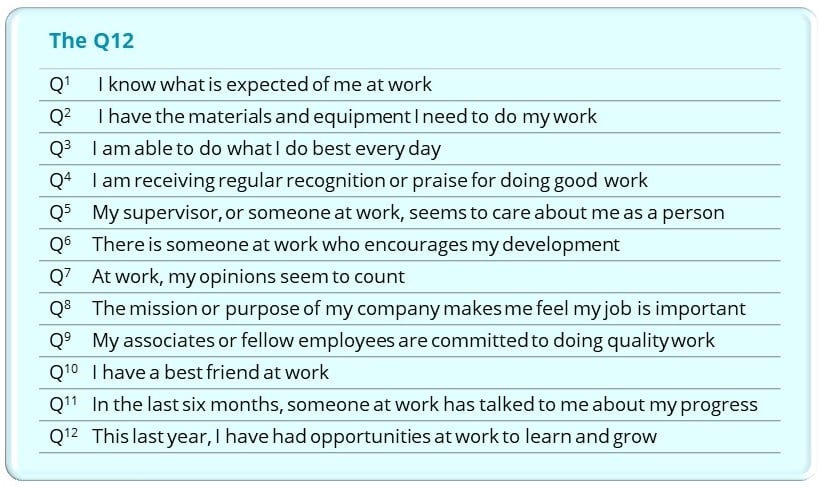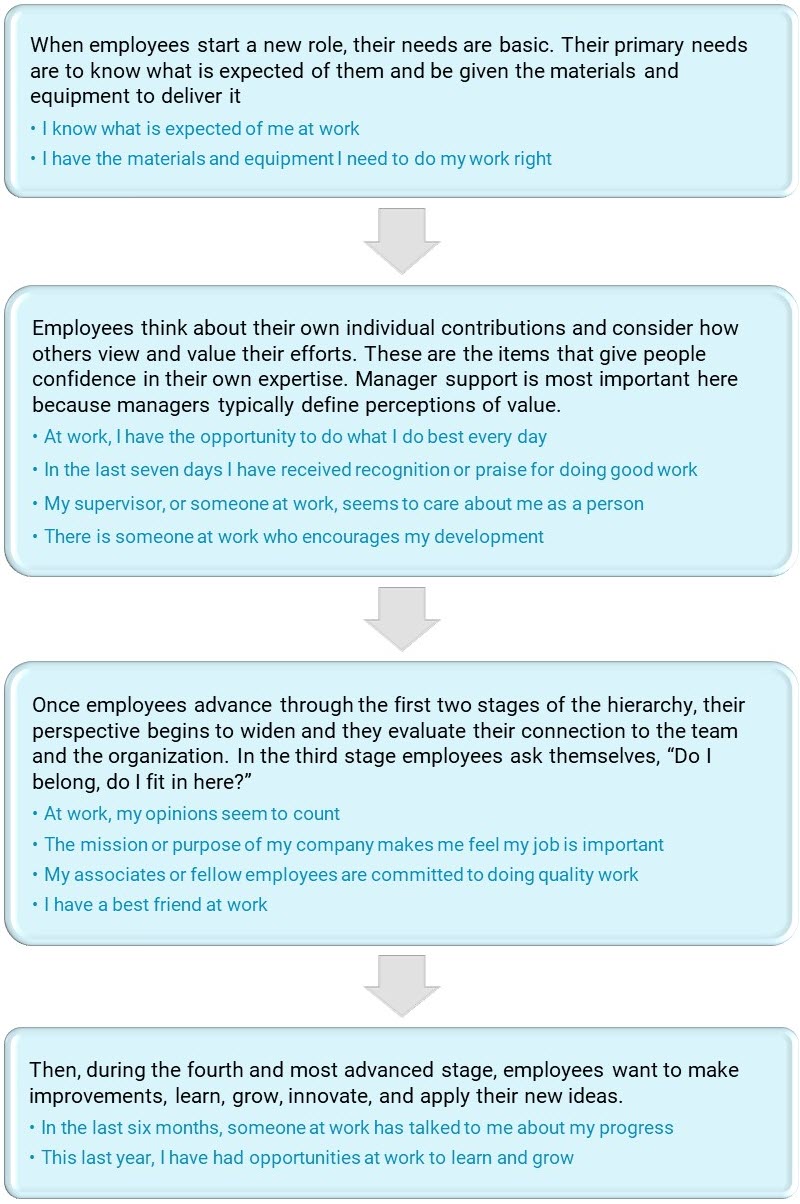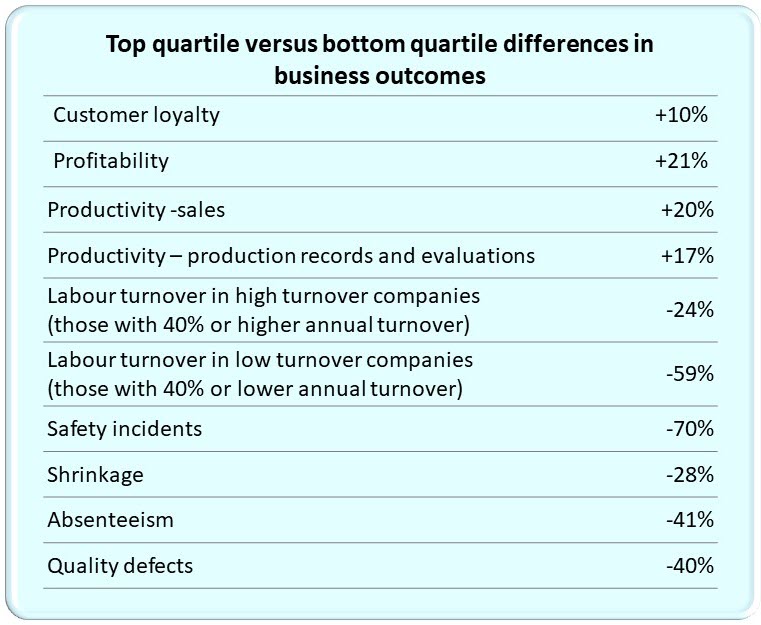Covid-19 has radically changed what people want from their performance management process and has accelerated the move to cloud based systems.
Covid-19 has made improving business performance a priority
HR leaders around the world are now reporting that their key business priority is improving business performance and productivity. This is a Covid-19 enforced, urgent business imperative and the focus is on how to do it quickly and deliver measurable, sustainable results.
Improving employee engagement is a proven way to do it
There is well researched science that shows that, improving the engagement of employees in a business significantly improves the business results. The fundamental platform upon which the ability to improve engagement depends is that people have a clear knowledge of what is expected of them at work and they have the necessary materials and equipment to deliver it.
Performance management tools provide the platform that enables it to be done
Mariner7 has created a flexible, cloud-based tool that enables agile goals to be agreed and changed easily as priorities change. Online feedback, discussion and coaching conversations, which are critical for staying focused on delivery can be initiated by the manager or the employee as frequently as required. Onboarding, employee generated feedback requests, development planning and annual reviews can all support the engagement process and create an environment where the employee takes ownership of their performance. However, we believe there is more to it than just the software.
In this paper
For over 20 years we have researched, developed and implemented performance systems and followed the research on employee engagement around the world. We have studied the effectiveness of many different approaches and, in particular, we have studied the critical factors that differentiate the successes from the failures. In this paper we provide our insights on those critical factors:
- Why the findings from Gallup’s 30 year research study on engagement and its impact on business outcomes is so important
- Why the order in which initiatives are undertaken is critical
- Why getting people to take ownership of their own performance is so important and how to do it
- The most efficient way to help people achieve their goals
- The Mariner7 road map – the critical steps and the order in which they must be taken
The twelve items of employee engagement
The largest and most comprehensive research study on engagement has been conducted by the Gallup organisation over the last 25 years. By gathering and analysing answers to over 100 million questions from over 1 million employees from organisations across sectors, industries and countries, they have scientifically defined what employee engagement is, how it can be measured, what impact it has on key business outcomes and how to improve it.1 Most importantly, by using sophisticated statistical analysis they have been able to distil this vast amount of data down to 12 items (which they have called the Q12 ) that together measure employee engagement. These items can be used in the form of an employee questionnaire to measure the strength of a team, business unit or the entire organisation:

These 12 items are the simplest and most accurate way to measure the strength of an organisation. They accurately differentiate engaged employees from the rest and enable changes across the organisation to be measured and matched against key business performance indicators.
The top six Q12 items are the most important
The top 6 items of the Q12 are the most powerful because they have the most consistent links to multiple business outcomes and therefore deliver the greatest business benefits. They are also the ones it is easiest to do something about to increase engagement. However, there is a key requirement:
Key insight 1:
The items need to be addressed in the right order
This is a fundamental requirement for your employee engagement improvement programme to succeed. The 12 items are arranged in order because some are more foundational than others and must be in place before work on the following items can be effective. The reason for this is simple and can be likened to climbing a high mountain.
Base camp must be set up first to provide the basic needs of climbers (food, equipment, oxygen, communications etc) and to allow them to acclimatise before higher levels can be attempted. If climbers attempt to climb to higher altitudes, before their basic requirements have been met, they will not cope with the lack of oxygen and will suffer from mountain sickness. They will have no choice but to return to base camp. For the same reason, helicoptering into a high level and then setting out quickly for the summit does not work either. The more time climbers spend at the lower levels the more stamina they have in the thin air near the summit.
In the business world, putting energy into higher levels is a waste of time if people don’t know what is expected of them and don’t have the resources to do it! Yet tackling higher levels before the basics are firmly in place is one of the most common mistakes companies have made over the last thirty years. It has been and continues to be a major reason why so many well-conceived initiatives fail.
The items are grouped into four stages
The Gallup model has the items grouped into four distinct stages.

The four stages require different skills, techniques and thinking from managers. They help them work through the areas most relevant to where their team is at on the journey to complete engagement.
Goal setting and managing goal delivery is the foundation. Nothing can successfully happen before this
Knowing what is expected of you at work is about agreeing your goals and targets with your manager and using regular performance conversations to keep focused on their delivery. In today’s Covid-19 remote world, best practice is to make sure that goals are agile or easily changed and agreed with the manager as business priorities change. Managing the delivery of these goals should be a simple, natural process:
- Goals should be stated as expected outcomes and agreed by the manager and employee
- the steps required to deliver them are determined by the employee, with coaching and feedback support from the manager.
Coaching conversations should focus on the future
For the process to work, it is critical that ongoing, regular coaching conversations can be held between the employee and their manager and the results recorded online. Progress is reported, priorities are discussed and confirmed, help and guidance is sought, issues, problems and ideas are discussed and feedback is given. These conversations should be able to be initiated by either party at any time and their frequency, is determined by what works best for each manager/employee pair. They can only practically be done using a performance management system such as Mariner7, which is designed to keep track of the conversations as they unfold over time and create a platform for creating the key elements of engagement.
Whilst the best managers do use a brief review of past performance to understand progress, give feedback or recognition and understand the employees style or needs, most of the performance conversation is focused on the future. Questions such as “what do you want to accomplish in the next two months?” “how will we measure progress?” “what is your most efficient route towards achieving these goals?” and “how can I help?” create energy, buy-in and commitment for the employee to take ownership of their performance and keep track of their progress.
Key insight 2:
Build on people’s strengths rather than focusing on weaknesses
Getting strong agreement to each of the top 6 items by each of their team members is one of each manager’s most important responsibilities. Because Gallup realised the challenges for managers to balance all these items with all of their team members, they undertook further research to find out if there was an approach that the best managers used that was more successful than the average. They found that top managers have less in common than you might think but there was one insight which tens of thousands of managers repeated:
“People don’t change that much. Instead of trying to add attributes to them to overcome their weaknesses try to capitalise on their strengths and make them better at what they are already good at. That is hard enough”.
By focusing on each person’s strengths and managing around their weaknesses a manager helps each person get better at what they are naturally good at. It is the most efficient way to help each person reach their goals.
Where should you start?
With your managers, starting at the top. Managers are the most important players in improving engagement. The Gallup research found that the top 25% of managers have an extraordinarily disproportionate influence on performance:
- They increase employee engagement by 13%
- They increase revenue by 23%
- They increase profit by 35%
- They reduce people turnover by 17% in low turnover organisations and by 9% in high turnover organisations
- They increase productivity in high complexity jobs by 22% and in medium complexity jobs by 10%
They found that 70% of an employee’s engagement is determined by their immediate manager. It is not that benefits, policies, the CEO’s leadership or pay are unimportant. It is just that the way the immediate manager manages is more important than any of these things in influencing the engagement of his or her people.
Managers themselves need to be engaged if they are to engage their people
Do not make the mistake of assuming your managers are engaged when starting your initiative. Using the Q12, Gallup found that 51% of the managers they surveyed were not engaged and 14% of them were actively disengaged. Measuring the level of engagement of your managers needs to be your starting point. Only then can you design a rollout plan that has a chance of being successful. An important tipping point is when managers realise that the most effective way for them to become successful is to help their people become successful.
Employee engagement has a known impact on business outcomes
In 1998 Gallup launched a study of 105,000 employees in 24 different companies to determine the effect that employee engagement had on four key business outcomes: productivity, profitability, employee retention and customer satisfaction. Their findings were significant:
- Business or work units scoring in the top half on employee engagement nearly double their odds of success compared to the bottom half
- Those at the 99th percentile have four times the success rate of those at the first percentile
- Every one of the Q12 items was linked to at least one of the four business outcomes
- Most of the items had links to two or more business outcomes
- Business units with more employees who said they know what is expected of them and have the materials and equipment to do their work right were substantially more productive than those with fewer employees saying this
- Nearly all the 12 items linked to productivity, including those measuring recognition, feeling cared about, individual development and opinions counting
- Nearly all the 12 items linked to profitability
- Retention and customer service both improved when employees had clear expectations, have an opportunity to do what they do best and feel like someone cares about them.
In the 2016 edition of the study, Gallup accumulated 339 research studies across 230 organisations in 49 industries with employees in 73 countries. They found that employee engagement influenced business outcomes and the results were highly generalisable across different organisations.
Key insight 3:
Doing things in the right order is the single biggest factor in determining the level of business benefits you deliver
The idea of an ordered hierarchy of needs is not new. Abraham Maslow published his hierarchy of needs in 1943, although at that time there was little scientific research to support it. His idea was that individuals' most basic needs must be met before they become motivated to achieve higher level needs. The Gallup research provides scientific support for this concept. The basic or primary needs are the psychological equivalent of survival. Pursuing higher level need is pointless until survival is assured.
The right order applies to the whole engagement project, not just the Q12
The organisation wide implementation includes a lot more to think about than just the Q12 and all these elements must be done in the right order. Measuring the engagement of managers, choosing which managers, business units and levels to start with, training people in goal setting, running performance conversations, providing feedback and assessing strengths and developing role strength profiles – is just the beginning. The list goes on. As an example of the importance of getting the order right, there is no point setting up a performance conversation process if, for example, the goals are not complete, they do not specify outcomes or the manager does not know how to make the conversation helpful and positive for the employee. Worst of all, there is absolutely no point if the manager is not engaged and not inclined to do any of this!
The Mariner7 roadmap provides the order to help you to plan your project
The urgency to improve business productivity and performance has made giving managers the tools that enable them to get the foundations right a high priority. They need tools but they must also be equipped to use them effectively. Getting the order right is critical to success. And remember, you get one shot at getting this right. It is very hard to be successful a second time if your first attempt fails!
The Mariner7 roadmap outlines the items and the order you need to take into account when planning your project. It is based on our twenty years of project implementation experience combined with the Gallup research. It provides a staged approach that delivers improved performance through improved employee engagement.
Appendix
- “First Break all the Rules – what the world’s greatest managers do differently”, from Gallup, foreword by Jim Harter, PhD, published by Gallup Press




